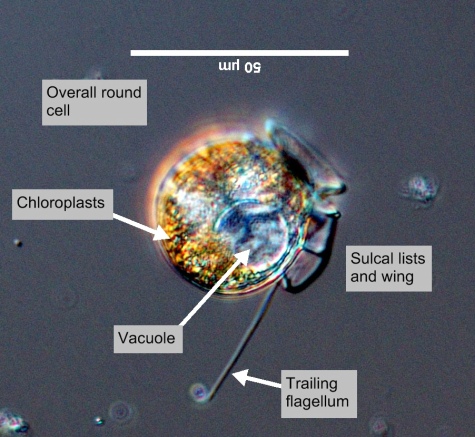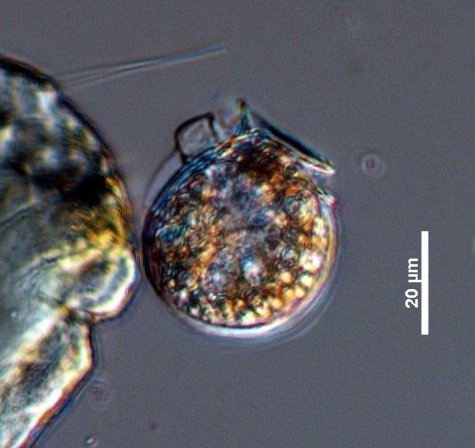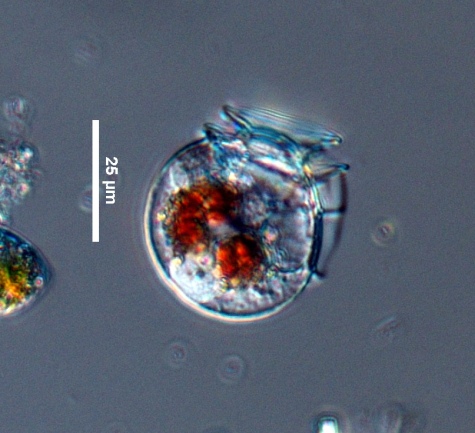



|
Synonym(s)
Classification
(Guiry and Guiry 2011)
Lifestyle
Binary fission
A form of asexual reproduction where one cell divides into two identical cells. All prokaryotes and some eukaryotes reproduce in this manner. Compare with mitosis, where the nucleus must also divide, adding an extra step to the process.
binary fission (Smithsonian 2012).Description
Dorsal
Relating to the back portion of the cell; opposite to the ventral side.
dorsally (Horner 2002). The lower CloseGirdle
In diatoms, the portion of the cell wall between the two valves of a cell; made up of intercalary bands (bands closest to the valves) and connecting bands (bands in the middle of the girdle). In dinoflagellates, the equivalent of a cingulum or transverse furrow (Horner 2002).
girdle list is wider than the upper (Horner 2002). Rows of ClosePoroid
A simple hole through the surface of a diatom valve (Smithsonian 2011).
poroids are visible on the theca (Horner 2002). Noticeable golden chloroplasts are present (Horner 2002).Measurements
Width: 22 μm
(Horner 2002)
Similar species
Harmful effects
Lipophilic
Having the ability to combine with or dissolve lipids.
lipophilic toxins CloseOkadoic acid
A polyether fatty acid that is produced by some species of dinoflagellates. The toxin responsible for Diarrhetic Shellfish Poisoning (DSP; Cohen et al. 1990).
(okadaic acid derivatives and ClosePectenotoxins
(PTX) A group of polyether-lactone toxins that have been detected in microalgae in Australia, Japan, New Zealand and in a number of European countries. They are exclusively produced by Dinophysis species and can be found in filter-feeding bivalve molluscs (e.g., oysters or mussels). There are no reports of human illness causally associated with exposure to these toxins. Pectenotoxins co-occur with the okadaic acid group of toxins, which makes it difficult to assess whether the PTX-group toxins contribute to human cases of diarrhetic shellfish poisoning (DSP; EFSA 2009b).
pectenotoxins) causing diarrhetic shellfish poisoning (DSP).Habitat
Distribution
Growth conditions
Environmental Ranges
Temperature range (°C): 15.927 - 19.935
Nitrate (μmol L-1): 0.307 - 1.078
Salinity: 37.924 - 39.077
Oxygen (mL L-1): 5.136 - 5.473
Phosphate (μmol L-1): 0.098 - 0.206
Close
Silicic acid
A general term to describe chemical compounds containing silicon, oxygen and hydrogen with a general formula of [SiOx(OH)4-2x]n. Diatoms polymerize silicic acid into biogenic silica to form their frustules (Azam and Chisholm 1976).
Silicate (μmol L-1): 1.542 - 2.121(EOL 2012)
Bloom characteristics
References
Encyclopedia of Life (EOL) 2012. Dinophysis parva Schiller 1933. http://eol.org/pages/901370/overview. Accessed 30 April 2012.
Guiry, M. D. and Guiry, G. M. 2011. Dinophysis parva Schiller. http://www.algaebase.org. Accessed on 12 September 2011.
Horner, R. A. 2002. A Taxonomic Guide To Some Common Phytoplankton. Biopress Limited, Dorset Press, Dorchester, UK. 200.
Smithsonian Institution 2012. Dinophysis fortii Pavillard 1923. http://botany.si.edu/references/dinoflag/Taxa/Dfortii.htm. Accessed 16 April 2012.
